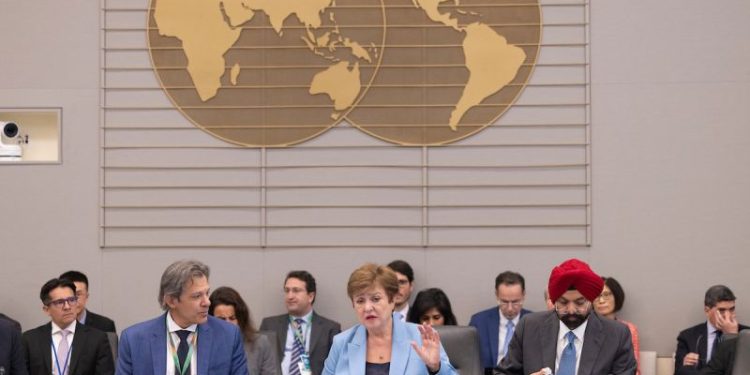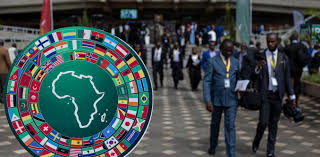- GSDR Pushes for Faster Debt Workouts and Greater Transparency as Ghana Nears Completion of Its Restructuring
When the Global Sovereign Debt Roundtable (GSDR) met in Washington on October 15, 2025, the tone was less about crisis response and more about consolidation. Yet the urgency was unmistakable. Co-chaired by IMF Managing Director Kristalina Georgieva, World Bank President Ajay Banga, and South Africa’s Finance Minister Enoch Godongwana, the Roundtable’s fifth progress report signalled a pivot from negotiation fatigue to structural reform: faster restructurings, better data, and smarter management of debt service pressures.
“Debt vulnerabilities remain elevated, particularly among low-income countries,” the report warns, “requiring continued coordinated efforts.”
Despite stabilisation since the pandemic, public debt ratios across low-income and emerging economies remain well above pre-COVID levels. For many, especially in sub-Saharan Africa, interest burdens and refinancing risks are squeezing fiscal space for education, health, and infrastructure.
Ghana features prominently in the GSDR update. According to the report, over 95 percent of Ghana’s debt treatment is now completed, with only a residual tranche of non-bonded commercial debt left to finalise. Four bilateral agreements have been signed, and the remainder are under negotiation. The country has already completed the fourth review of its IMF programme and stands among the Common Framework’s relative success stories, alongside Zambia and Ethiopia, where restructuring timelines have visibly shortened.
The GSDR credits this progress partly to earlier and more consistent information-sharing among debtor governments, official creditor committees, and private bondholders. It recommends that countries convene joint meetings of all creditor groups early in the process, an approach that Ghana informally adopted to avoid sequential, drawn-out talks.
Yet obstacles persist. The Roundtable noted that most delays occur between the signing of official creditor memoranda of understanding (MOUs) and their conversion into legally binding bilateral agreements. Publishing public timetables and regular updates on signature status, the report argues, could inject transparency and discipline into what remains a highly fragmented process.
A key evolution in the GSDR’s agenda is its support for countries whose debts are sustainable but whose debt-service burdens remain crippling. Through the IMF/World Bank “three-pillar approach,” these nations could access tools such as liability management operations (LMOs), including voluntary debt buybacks, swaps, and credit-enhanced refinancing, to ease liquidity constraints without triggering rating downgrades.
The report reveals plans for practical “how-to” guidance notes on LMOs to help finance ministries structure such operations. Ghana’s Finance Ministry, already exploring post-restructuring liability management options, is likely to benefit directly from these guidelines.
“Higher growth would, in turn, improve medium-term debt ratios,” the report notes, linking liquidity relief to growth-focused spending.
Perhaps the most forward-looking element of the October report is its emphasis on digital debt data reconciliation. The World Bank’s pilot project in Indonesia, highlighted by the GSDR, automates the exchange of loan data between debtor and creditor systems, potentially ending the manual, error-prone reconciliation that plagues many African finance ministries.
Expanding this to all G20 creditors could revolutionise transparency. For Ghana and other African issuers, it could mean real-time access to verified debt data, lower transaction costs, and faster restructuring timelines. The Roundtable also urged new scrutiny of collateralised loans and opaque financing arrangements, warning that such instruments conceal contingent liabilities and heighten systemic risk.
Looking ahead, the GSDR plans to issue an updated “Restructuring Playbook” in April 2026, incorporating lessons from current cases. It will also host technical workshops on contentious issues such as the treatment of state-owned enterprise debt, export-credit-agency guarantees, and collateralised instruments, areas where classification and transparency remain opaque.
For Ghana, these deliberations matter beyond semantics. As the country prepares for its fifth IMF programme review, clarity on how residual commercial loans are classified could determine both its final restructuring costs and its return to international markets.
The GSDR’s fifth report captures a subtle but critical shift: from reactive crisis management to systemic prevention. It calls for strengthening domestic debt management offices, expanding debtor-investor relations, and embedding transparency norms across creditor classes.
While consensus remains elusive on several fronts, including comparability of treatment and full disclosure of restructuring terms, the Roundtable’s momentum signals a growing recognition that sovereign debt architecture must evolve beyond ad-hoc improvisation.
As the IMF and World Bank prepare for the April 2026 milestones, Ghana’s near-completion status will serve as both a benchmark and a cautionary tale: success is possible, but only when information flows freely, timelines are respected, and domestic reforms stay on course.








